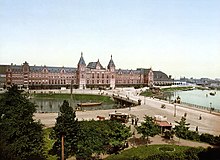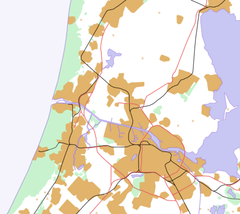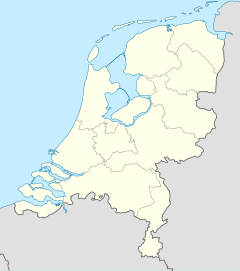Amsterdam Centraal station
Amsterdam Centraal station (Dutch: Station Amsterdam Centraal [staːˈɕɔn ˌɑmstərˈdɑm sɛnˈtraːl]; abbreviation: Asd) is the largest railway station in Amsterdam, North Holland, the Netherlands. A major international railway hub, it is used by 192,000 passengers a day, making it the second busiest railway station in the country after Utrecht Centraal and the most visited Rijksmonument of the Netherlands.[1][2]
National and international railway services at Amsterdam Centraal are provided by NS (Nederlandse Spoorwegen), the principal rail operator in the Netherlands. Amsterdam Centraal is the northern terminus of Amsterdam Metro routes 51, 53, 54, and stop for 52 operated by municipal public transport operator GVB. It is also served by a number of GVB tram and ferry routes as well as local and regional bus routes operated by GVB, Connexxion and EBS.
Amsterdam Centraal was designed by Dutch architect Pierre Cuypers and opened in 1889. It features a Gothic, Renaissance Revival station building[3] and a cast iron platform roof spanning approximately 40 metres.
Since 1997, the station building, underground passages, metro station, and the surrounding area have been undergoing major reconstruction and renovation works to accommodate the North-South Line metro route, which was opened on 22 July 2018. Amsterdam Centraal has the second longest railway platform in the Netherlands with a length of 695 metres. Due to the length, each platform may serve two trains, while one embarks from side "a" of a platform and the other, from side "b".
History
[edit]Construction
[edit]



Amsterdam Centraal was designed by Pierre Cuypers, who is also known for his design of the Rijksmuseum in Amsterdam. While Cuypers was the principal architect, it is believed that he focused mostly on the decoration of the station building and left the structural design to railway engineers.[4] The station was built by contractor Philipp Holzmann. The new central station replaced Amsterdam Willemspoort Station, which had closed in 1878, as well as the temporary Westerdok Station used from 1878 to 1889. The idea for a central station came from Johan Rudolph Thorbecke, then the Netherlands Minister of the Interior and responsible for the national railways, who, in 1884, laid two proposals before the Amsterdam municipal council. In the first proposal, the station would be situated between the Leidseplein and the Amstel river. In the other, it would be built in the open harbour front allowing for the station to be connected to the existing main lines in the area to the west and the south, but also to a projected new northern line.[5]
Cuypers' design of the station building in many ways strongly resembled his other architectural masterpiece, the Rijksmuseum, of which the construction had begun in 1876. It features a palace-like, Gothic/Renaissance Revival facade,[3] with two turrets and many ornamental details and stone reliefs referring to the capital city's industrial and commercial importance. A royal waiting room for the Dutch monarchy (one of three in active use in the country today) was also included in the design.[6] Cuypers' station reflects the romantic nationalistic mood in the late nineteenth-century Netherlands, with its many decorative elements glorifying the nation's economic and colonial power at the time.[7][8]
As with the Rijksmuseum, the station's overall architecture reminded many contemporaries of medieval cathedrals.[4] For that reason, as well as for the fact that it became increasingly clear that the national government wanted the station to be built at the city's waterfront effectively separating the city from the IJ lake, the plan was highly controversial. In his book on the history of city, Amsterdam historian Geert Mak writes that:
Almost all of Amsterdam's own experts and others involved thought this to be a catastrophic plan, 'the most disgusting possible attack on the beauty and glory of the capital'. Nevertheless, the building of the Central Station in front of the open harbour was forced through by the railway department of the Ministry of Transport in The Hague, and the Home Secretary, Thorbecke. Finally, the plan made its way through the Amsterdam municipal council by a narrow majority.[9]
Construction works started in 1882.[10] The station is built on three interconnected artificial islands in the IJ lake. These islands were created with sand taken from the dunes near Velsen, which had become available as a result of the excavation of the North Sea Canal. The islands together are known as Stationseiland (Station Island). Like many other structures in Amsterdam, the station was built on wooden piles (8,687 pieces). The construction of the station was delayed because of the instability of the soil, which set back the completion of the work by several years. The station building was completed in 1884, but the commission to Cuypers did not include the roofwork of the platforms. Therefore, the station did not yet feature its distinctive station roof. This roof, consisting of 50 curved trusses and a span of almost 45 meters (147 ft 8 in), was designed by L.J. Eijmer, a civil engineer with the private railroad company Staatsspoorwegen. The roof was manufactured by Andrew Handyside and Company of Derby, England.[11] Cuypers did design the decorations for the trusses and the gable ends. On 15 October 1889, the station was officially opened, drawing large numbers of crowds. The visitors were charged 0.25 guilders to see the station; in the first two days after the opening, several dozens of thousands paid.[12] The opening of the central station marked the city's transition from a waterfront city to an inland city, spurring further redevelopment activities in the city centre which included the realignment of streets and the filling up of canals. The waterways would soon be replaced by tramways and cars as the primary modes of transport in the city.[5]
In 1920, the East Wing of the station (the lower end of the building) was demolished and replaced by "The East", a postal service building designed by Cuypers' son Joseph. A second, narrower and longer but similar roof on the north side of the station was completed in 1922.
Early expansions and modernization
[edit]In the 1950s, a pedestrian tunnel was created between the station and the road in front of it, which terminated inside the station. With the construction of the metro tunnel in the late 1970s, both the pedestrian tunnel and the road in front of the station disappeared. In the early 1980s, the central hall and middle tunnel were considerably widened and modernized. In the 1990s, a new signaling post was built on the western side of the station. In addition, the number of tracks on that side was expanded in order to increase capacity in the direction of Sloterdijk station. In 1996, a third, 'centre roof' designed by Jan Garvelink, architect at Holland Rail Consult, was built between the two existing roofs, whereby all platforms at the station were now covered.
Later reform and expansion
[edit]Since 1997, the station has been continuously undergoing reconstruction works because of the development of the North-South Line of the Amsterdam Metro, which was originally planned to be completed in 2014. Due to several setbacks, some at the Amsterdam Centraal building site, the line was fully completed in 2018. Construction works at the station include a renovation of the station building, including the reconstruction of original station features which had disappeared over the years, a redevelopment of the Stationsplein (Station Square), and a new bus station on the north side of the station. In 2000, the new western passenger tunnel opened replacing the main tunnel in the centre of the station which was shut down enabling the construction of the new metro line. In 2004, platforms 10-15 were extended to accommodate international high-speed rail services. Construction works for the bus station commenced in 2003, opened in 2009 and finished in 2014. It includes the construction of a fourth station roof and a station hall with space for shops and restaurants. It replaces 5 small bus stations and several isolated bus stops across the Station Island. With all buses eventually moving to the new bus station on the north side, the Station Island should only be accessible to pedestrians, cyclists and trams.
The three passenger tunnels underneath the station were upgraded and provided with convenience stores and kiosks. In addition, two new passageways were created enabling the hosting of larger retail stores, geared towards passengers who have more time to spend at the station.
On 4 February 2020, the Minister of Infrastructure and Water Management, Cora van Nieuwenhuizen, and the UK Transport Secretary, Grant Shapps, announced that juxtaposed controls would be established in the station. According to the announcement, starting from 30 April 2020, Eurostar passengers travelling to the UK would clear exit checks from the Schengen Area as well as UK entry checks (conducted by the UK Border Force) in the station before boarding their train (without having to disembark at Brussels-South station, go through the juxtaposed controls there, and re-board the train before continuing their journey to the UK).[13][14] However, the launch was postponed due to the COVID-19 pandemic.[15] The inauguration of juxtaposed controls in the station subsequently took place on 26 October 2020.[16][17]
From 2017 there will be further reconstruction works at the station. A number of platforms will be widened making use of the tracks which do not currently have platforms. This means that alterations will be made in the tunnels under the platforms again. Furthermore, the eastern tunnel will be made wider, based on the example of the middle tunnel. The old railway bridges to the east of the station will also be replaced.
Railway station layout
[edit]
Amsterdam Centraal station | |||||||||||||||||||||||||||||||||||||||||||||||||||||||||||||||||||||||||||||||||||||||||||||||||||||||||||||||||||||||||||||||||||||||||||||||||||||||||||||||||||||||||||||||||||||||||||||||||||||||||||||||||||||||||||||||||||||||||||||||||||||||||
|---|---|---|---|---|---|---|---|---|---|---|---|---|---|---|---|---|---|---|---|---|---|---|---|---|---|---|---|---|---|---|---|---|---|---|---|---|---|---|---|---|---|---|---|---|---|---|---|---|---|---|---|---|---|---|---|---|---|---|---|---|---|---|---|---|---|---|---|---|---|---|---|---|---|---|---|---|---|---|---|---|---|---|---|---|---|---|---|---|---|---|---|---|---|---|---|---|---|---|---|---|---|---|---|---|---|---|---|---|---|---|---|---|---|---|---|---|---|---|---|---|---|---|---|---|---|---|---|---|---|---|---|---|---|---|---|---|---|---|---|---|---|---|---|---|---|---|---|---|---|---|---|---|---|---|---|---|---|---|---|---|---|---|---|---|---|---|---|---|---|---|---|---|---|---|---|---|---|---|---|---|---|---|---|---|---|---|---|---|---|---|---|---|---|---|---|---|---|---|---|---|---|---|---|---|---|---|---|---|---|---|---|---|---|---|---|---|---|---|---|---|---|---|---|---|---|---|---|---|---|---|---|---|---|---|---|---|---|---|---|---|---|---|---|---|---|---|---|---|---|
| |||||||||||||||||||||||||||||||||||||||||||||||||||||||||||||||||||||||||||||||||||||||||||||||||||||||||||||||||||||||||||||||||||||||||||||||||||||||||||||||||||||||||||||||||||||||||||||||||||||||||||||||||||||||||||||||||||||||||||||||||||||||||


 French
French Deutsch
Deutsch

